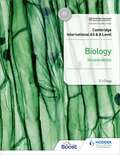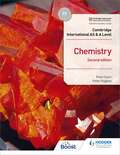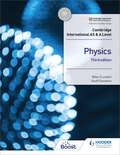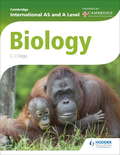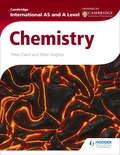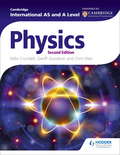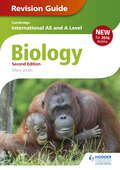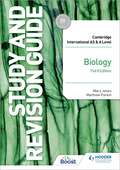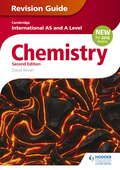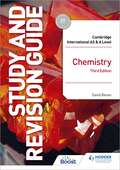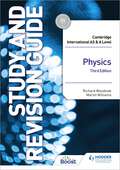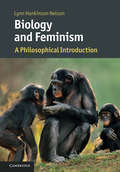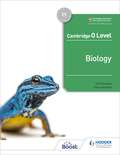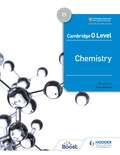- Table View
- List View
Cambridge International AS & A Level Biology Student's Book 2nd edition
by C. J. CleggThis title is endorsed by Cambridge Assessment International Education to support the full syllabus for examination from 2022.Confidently navigate the updated Cambridge International AS & A Level Biology (9700) syllabus with a structured approach ensuring that the link between theory and practice is consolidated, scientific skills are applied, and analytical skills developed.- Enable students to monitor and build progress with short 'self-assessment' questions throughout the student text, with answers at the back of the book, so students can check their understanding as they work their way through the chapters.- Build scientific communication skills and vocabulary in written responses with a variety of exam-style questions. - Encourage understanding of historical context and scientific applications with extension boxes in the student text.- Have confidence that lessons cover the syllabus completely with a free Scheme of Work available online.- Provide additional practice with the accompanying write-in Practical Skills Workbooks, which once completed, can also be used to recap learning for revision. Also available in the series:Chemistry Student Book 9781510480230 Physics Student Book 9781510482807 Biology Student eTextbook 9781510482913 Biology Whiteboard eTextbook 9781510482920 Chemistry Student eTextbook 9781510482999Chemistry Whiteboard eTextbook 9781510483002 Physics Student eTextbook 9781510483118 Physics Whiteboard eTextbook 9781510483125 Biology Skills Workbook 9781510482869Chemistry Skills Workbook 9781510482852Physics Skills Workbook 9781510482845
Cambridge International AS & A Level Chemistry Student's Book Second Edition
by Peter Hughes Peter CannThis title is endorsed by Cambridge Assessment International Education to support the full syllabus for examination from 2022.Confidently navigate the updated Cambridge International AS & A Level Chemistry (9701) syllabus with a structured approach ensuring that the link between theory and practice is consolidated, scientific skills are applied, and analytical skills developed.- Enable students to monitor and build progress with short 'self-assessment' questions throughout the student text, with answers at the back of the book, so students can check their understanding as they work their way through the chapters.- Build scientific communication skills and vocabulary in written responses with a variety of exam-style questions. - Encourage understanding of historical context and scientific applications with extension boxes in the student text.- Have confidence that lessons cover the syllabus completely with a free Scheme of Work available online.- Provide additional practice with the accompanying write-in Practical Skills Workbooks, which once completed, can also be used to recap learning for revision.
Cambridge International AS & A Level Chemistry Student's Book Second Edition
by Peter Hughes Peter CannThis title is endorsed by Cambridge Assessment International Education to support the full syllabus for examination from 2022.Confidently navigate the updated Cambridge International AS & A Level Chemistry (9701) syllabus with a structured approach ensuring that the link between theory and practice is consolidated, scientific skills are applied, and analytical skills developed.- Enable students to monitor and build progress with short 'self-assessment' questions throughout the student text, with answers at the back of the book, so students can check their understanding as they work their way through the chapters.- Build scientific communication skills and vocabulary in written responses with a variety of exam-style questions. - Encourage understanding of historical context and scientific applications with extension boxes in the student text.- Have confidence that lessons cover the syllabus completely with a free Scheme of Work available online.- Provide additional practice with the accompanying write-in Practical Skills Workbooks, which once completed, can also be used to recap learning for revision.Also available in the series:Biology Student Book 9781510482876 Physics Student Book 9781510482807 Biology Student eTextbook 9781510482913 Biology Whiteboard eTextbook 9781510482920 Chemistry Student eTextbook 9781510482999Chemistry Whiteboard eTextbook 9781510483002 Physics Student eTextbook 9781510483118 Physics Whiteboard eTextbook 9781510483125 Biology Skills Workbook 9781510482869Chemistry Skills Workbook 9781510482852Physics Skills Workbook 9781510482845
Cambridge International AS & A Level Physics Student's Book 3rd edition
by Geoff Goodwin Mike CrundellThis title is endorsed by Cambridge Assessment International Education to support the full syllabus for examination from 2022.Confidently navigate the updated Cambridge International AS & A Level Physics (9702) syllabus with a structured approach ensuring that the link between theory and practice is consolidated, scientific skills are applied, and analytical skills developed.- Enable students to monitor and build progress with short 'self-assessment' questions throughout the student text, with answers at the back of the book, so students can check their understanding as they work their way through the chapters.- Build scientific communication skills and vocabulary in written responses with a variety of exam-style questions. - Encourage understanding of historical context and scientific applications with extension boxes in the student text.- Have confidence that lessons cover the syllabus completely with a free Scheme of Work available online.- Provide additional practice with the accompanying write-in Practical Skills Workbooks, which once completed, can also be used to recap learning for revision.
Cambridge International AS & A Level Physics Student's Book 3rd edition
by Geoff Goodwin Mike CrundellThis title is endorsed by Cambridge Assessment International Education to support the full syllabus for examination from 2022.Confidently navigate the updated Cambridge International AS & A Level Physics (9702) syllabus with a structured approach ensuring that the link between theory and practice is consolidated, scientific skills are applied, and analytical skills developed.- Enable students to monitor and build progress with short 'self-assessment' questions throughout the student text, with answers at the back of the book, so students can check their understanding as they work their way through the chapters.- Build scientific communication skills and vocabulary in written responses with a variety of exam-style questions. - Encourage understanding of historical context and scientific applications with extension boxes in the student text.- Have confidence that lessons cover the syllabus completely with a free Scheme of Work available online.- Provide additional practice with the accompanying write-in Practical Skills Workbooks, which once completed, can also be used to recap learning for revision.
Cambridge International AS and A Level Biology
by C. J. CleggThis title covers the entire syllabus for Cambridge International Examinations' International AS and A Level Biology (9700). It is divided into separate sections for AS and A Level making it ideal for students studying both the AS and the A Level and also those taking the AS examinations at the end of their first year.- Explains difficult concepts using language that is appropriate for students around the world- Provides practice throughout the course with carefully selected past paper questions at the end of each chapterWe are working with Cambridge International Examinations to gain endorsement for this title.
Cambridge International AS and A Level Chemistry
by Peter Hughes Peter CannEndorsed by Cambridge International Examinations Covers the entire syllabus for Cambridge International Examinations' International AS and A Level Chemistry (9701). It is divided into separate sections for AS and A Level making it ideal for students studying both the AS and the A Level and also those taking the AS examinations at the end of their first year. - Explains difficult concepts using language that is appropriate for students around the world - Provides practice throughout the course with carefully selected past paper questions at the end of each chapter
Cambridge International AS and A Level Physics 2nd ed
by Chris Mee Geoff Goodwin Mike CrundellClear coverage of the latest specification from an experienced author team of examiners and teachers, plus a free Student's CD-ROM. This new edition follows the syllabus exactly and is written in two parts, reflecting the AS and A Level section division of the syllabus. - Improves exam performance with annotated sample exam answers at three levels - Offers additional support on a Student's CD-ROM, included with every book - Provides opportunities for self assesment with worked examples and consolidation questions The Student's CD-ROM features: - interactive tests - topic summaries - key terms - additional questions - a revision checklist for each topic - informations and advice in revision planning
Cambridge International AS/A Level Biology Revision Guide 2nd edition
by Mary JonesGet your best grades with this exam-focused text that will guide you through the content and skills you need to prepare for the big day.Manage your own revision with step-by-step support from experienced examiner and author Mary Jones. This guide also includes a Questions and Answers section with exam-style questions, student's answers for each question, and examiner comments to ensure you're exam-ready.- Plan and pace your revision with the revision planner- Use the expert tips to clarify key points- Avoid making typical mistakes with expert advice- Test yourself with end-of-topic questions and answers and tick off each topic as you complete it- Practise your exam skills with exam-style questions and answersThis title has not been through the Cambridge International endorsement process.
Cambridge International AS/A Level Biology Study and Revision Guide Third Edition (Cambridge International AS and A Level)
by Mary Jones Matthew ParkinStretch yourself to achieve the highest grades, with structured syllabus coverage, varied exam-style questions and annotated sample answers, to help you to build the essential skill set for exam success.- Benefit from expert advice and tips on skills and knowledge from experienced subject authors- Effectively manage your revision with a brand-new introduction that clearly outlines what is expected from you in the exam- Keep track of your own progress with a handy revision planner- Use the new glossary-index section to identify and address gaps in knowledge- Consolidate and apply your understanding of key content and skills with short 'Test yourself' and exam-style questions
Cambridge International AS/A Level Biology Study and Revision Guide Third Edition (Cambridge International AS and A Level)
by Mary Jones Matthew ParkinStretch yourself to achieve the highest grades, with structured syllabus coverage, varied exam-style questions and annotated sample answers, to help you to build the essential skill set for exam success.- Benefit from expert advice and tips on skills and knowledge from experienced subject authors- Effectively manage your revision with a brand-new introduction that clearly outlines what is expected from you in the exam- Keep track of your own progress with a handy revision planner- Use the new glossary-index section to identify and address gaps in knowledge- Consolidate and apply your understanding of key content and skills with short 'Test yourself' and exam-style questions
Cambridge International AS/A Level Chemistry Revision Guide 2nd edition
by David BevanGet your best grades with this exam-focused text that will guide you through the content and skills you need to prepare for the big day.Manage your own revision with step-by-step support from experienced examiner and author David Bevan. This guide also includes a Questions and Answers section with exam-style questions, student's answers for each question, and examiner comments to ensure you're exam-ready.- Plan and pace your revision with the revision planner- Use the expert tips to clarify key points- Avoid making typical mistakes with expert advice- Test yourself with end-of-topic questions and answers and tick off each topic as you complete it- Practise your exam skills with exam-style questions and answersThis title has not been through the Cambridge International endorsement process.
Cambridge International AS/A Level Chemistry Study and Revision Guide Third Edition
by David BevanStretch yourself to achieve the highest grades, with structured syllabus coverage, varied exam-style questions and annotated sample answers, to help you to build the essential skill set for exam success.- Benefit from expert advice and tips on skills and knowledge from experienced subject authors- Effectively manage your revision with a brand-new introduction that clearly outlines what is expected from you in the exam- Keep track of your own progress with a handy revision planner- Use the new glossary-index section to identify and address gaps in knowledge- Consolidate and apply your understanding of key content and skills with short 'Test yourself' and exam-style questions
Cambridge International AS/A Level Chemistry Study and Revision Guide Third Edition
by David BevanStretch yourself to achieve the highest grades, with structured syllabus coverage, varied exam-style questions and annotated sample answers, to help you to build the essential skill set for exam success.- Benefit from expert advice and tips on skills and knowledge from experienced subject authors- Effectively manage your revision with a brand-new introduction that clearly outlines what is expected from you in the exam- Keep track of your own progress with a handy revision planner- Use the new glossary-index section to identify and address gaps in knowledge- Consolidate and apply your understanding of key content and skills with short 'Test yourself' and exam-style questions
Cambridge International AS/A Level Physics Revision Guide second edition
by Richard WoodsideGet your best grades with this exam-focused text that will guide you through the content and skills you need to prepare for the big day.Manage your own revision with step-by-step support from experienced examiner and author Richard Woodside. This guide also includes a Questions and Answers section with exam-style questions, student's answers for each question, and examiner comments to ensure you're exam-ready.- Plan and pace your revision with the revision planner- Use the expert tips to clarify key points- Avoid making typical mistakes with expert advice- Test yourself with end-of-topic questions and answers and tick off each topic as you complete it- Practise your exam skills with exam-style questions and answersThis title has not been through the Cambridge International endorsement process.
Cambridge International AS/A Level Physics Study and Revision Guide Third Edition (Cambridge International AS and A Level)
by Martin Williams Richard WoodsideStretch yourself to achieve the highest grades, with structured syllabus coverage, varied exam-style questions and annotated sample answers, to help you to build the essential skill set for exam success.- Benefit from expert advice and tips on skills and knowledge from experienced subject authors- Effectively manage your revision with a brand-new introduction that clearly outlines what is expected from you in the exam- Keep track of your own progress with a handy revision planner- Use the new glossary-index section to identify and address gaps in knowledge- Consolidate and apply your understanding of key content and skills with short 'Test yourself' and exam-style questions
Cambridge International AS/A Level Physics Study and Revision Guide Third Edition (Cambridge International AS and A Level)
by Martin Williams Richard WoodsideStretch yourself to achieve the highest grades, with structured syllabus coverage, varied exam-style questions and annotated sample answers, to help you to build the essential skill set for exam success.- Benefit from expert advice and tips on skills and knowledge from experienced subject authors- Effectively manage your revision with a brand-new introduction that clearly outlines what is expected from you in the exam- Keep track of your own progress with a handy revision planner- Use the new glossary-index section to identify and address gaps in knowledge- Consolidate and apply your understanding of key content and skills with short 'Test yourself' and exam-style questions
Cambridge Introductions to Philosophy and Biology: A Philosophical Introduction (Cambridge Introductions to Philosophy and Biology)
by Nelson Lynn HankinsonThis book provides a unique introduction to the study of relationships between gender and biology, a core part of the feminist science research tradition which emerged nearly half a century ago. Lynn Hankinson Nelson presents an accessible and balanced discussion of research questions, background assumptions, methods, and hypotheses about biology and gender with which feminist scientists and science scholars critically and constructively engage. Writing from the perspective of contemporary philosophy of science, she examines the evidence for and ethical implications of biological hypotheses about gender, and discusses relevant philosophical issues including understandings of scientific objectivity, the nature of scientific reasoning, and relationships between biological research and the scientific and social contexts in which it is pursued. Clear and comprehensive, this volume addresses the engagements of feminist scientists and science scholars with a range of disciplines, including developmental and evolutionary biology, medicine, neurobiology, and primatology.
Cambridge Molecular Science: Fundamentals of Sum-Frequency Spectroscopy
by Y. R. ShenThe first book on the topic, and written by the founder of the technique, this comprehensive resource provides a detailed overview of sum-frequency spectroscopy, its fundamental principles, and the wide range of applications for surfaces, interfaces, and bulk. Beginning with an overview of the historical context, and introductions to the basic theory of nonlinear optics and surface sum-frequency generation, topics covered include discussion of different experimental arrangements adopted by researchers, notes on proper data analysis, an up-to-date survey commenting on the wide range of successful applications of the tool, and a valuable insight into current unsolved problems and potential areas to be explored in the future. With the addition of chapter appendices that offer the opportunity for more in-depth theoretical discussion, this is an essential resource that integrates all aspects of the subject and is ideal for anyone using, or interested in using, sum-frequency spectroscopy.
Cambridge O Level Biology
by Dave Hayward D. G. MackeanThis title has been endorsed by Cambridge Assessment International Education.Written by renowned expert authors, our updated resources enable the learner to effectively navigate through the content of the revised Cambridge O Level Biology (5090) syllabus for examination from 2023.- Develop strong practical skills: practical skills features provide guidance on key experiments, interpreting experimental data, and evaluating results; supported by practice questions for preparation for practical exams or alternatives.- Build mathematical skills: worked examples demonstrate the key mathematical skills in scientific contexts; supported by follow-up questions to put these skills into practice.- Consolidate skills and check understanding: self-assessment questions, exam-style questions and checklists are embedded throughout the book, alongside key definitions of technical terms and a Glossary.- Navigate the syllabus confidently: content flagged clearly with introductions to each topic outlining the learning objectives and context. - Deepen and enhance scientific knowledge: going further boxes throughout encourage students to take learning to the next level.
Cambridge O Level Biology
by Dave Hayward D. G. MackeanThis title has been endorsed by Cambridge Assessment International Education.Written by renowned expert authors, our updated resources enable the learner to effectively navigate through the content of the revised Cambridge O Level Biology (5090) syllabus for examination from 2023.- Develop strong practical skills: practical skills features provide guidance on key experiments, interpreting experimental data, and evaluating results; supported by practice questions for preparation for practical exams or alternatives.- Build mathematical skills: worked examples demonstrate the key mathematical skills in scientific contexts; supported by follow-up questions to put these skills into practice.- Consolidate skills and check understanding: self-assessment questions, exam-style questions and checklists are embedded throughout the book, alongside key definitions of technical terms and a Glossary.- Navigate the syllabus confidently: content flagged clearly with introductions to each topic outlining the learning objectives and context. - Deepen and enhance scientific knowledge: going further boxes throughout encourage students to take learning to the next level.
Cambridge O Level Chemistry
by Bryan Earl Doug WilfordWritten by renowned expert authors, our updated resources enable the learner to effectively navigate through the content of the revised Cambridge Chemistry (5070) syllabus for examination from 2023.- Develop strong practical skills: practical skills features provide guidance on key experiments, interpreting experimental data, and evaluating results; supported by practice questions for preparation for practical exams or alternatives.- Build mathematical skills: worked examples demonstrate the key mathematical skills in scientific contexts; supported by follow-up questions to put these skills into practice.- Consolidate skills and check understanding: self-assessment questions, exam-style questions and checklists are embedded throughout the book, alongside key definitions of technical terms and a Glossary.- Navigate the syllabus confidently: content flagged clearly with introductions to each topic outlining the learning objectives and context. - Deepen and enhance scientific knowledge: going further boxes throughout encourage students to take learning to the next level.
Cambridge O Level Chemistry
by Bryan Earl Doug WilfordWritten by renowned expert authors, our updated resources enable the learner to effectively navigate through the content of the revised Cambridge Chemistry (5070) syllabus for examination from 2023.- Develop strong practical skills: practical skills features provide guidance on key experiments, interpreting experimental data, and evaluating results; supported by practice questions for preparation for practical exams or alternatives.- Build mathematical skills: worked examples demonstrate the key mathematical skills in scientific contexts; supported by follow-up questions to put these skills into practice.- Consolidate skills and check understanding: self-assessment questions, exam-style questions and checklists are embedded throughout the book, alongside key definitions of technical terms and a Glossary.- Navigate the syllabus confidently: content flagged clearly with introductions to each topic outlining the learning objectives and context. - Deepen and enhance scientific knowledge: going further boxes throughout encourage students to take learning to the next level.
Cambridge O Level Physics
by Tom Duncan Heather KennettThis title is endorsed by Cambridge Assessment International Education to support the full syllabus for examination from 2023.Written by renowned expert authors, our updated resources enable the learner to effectively navigate through the content of the revised Cambridge O Level Physics (5054) syllabus for examination from 2023.- Develop strong practical skills: practical skills features provide guidance on key experiments, interpreting experimental data, and evaluating results; supported by practice questions for preparation for practical exams or alternatives.- Build mathematical skills: worked examples demonstrate the key mathematical skills in scientific contexts; supported by follow-up questions to put these skills into practice.- Consolidate skills and check understanding: self-assessment questions, exam-style questions and checklists are embedded throughout the book, alongside key definitions of technical terms and a Glossary.- Navigate the syllabus confidently: content flagged clearly with introductions to each topic outlining the learning objectives and context. - Deepen and enhance scientific knowledge: going further boxes throughout encourage students to take learning to the next level.
Cambridge O Level Physics
by Tom Duncan Heather KennettThis title is endorsed by Cambridge Assessment International Education to support the full syllabus for examination from 2023.Written by renowned expert authors, our updated resources enable the learner to effectively navigate through the content of the revised Cambridge O Level Physics (5054) syllabus for examination from 2023.- Develop strong practical skills: practical skills features provide guidance on key experiments, interpreting experimental data, and evaluating results; supported by practice questions for preparation for practical exams or alternatives.- Build mathematical skills: worked examples demonstrate the key mathematical skills in scientific contexts; supported by follow-up questions to put these skills into practice.- Consolidate skills and check understanding: self-assessment questions, exam-style questions and checklists are embedded throughout the book, alongside key definitions of technical terms and a Glossary.- Navigate the syllabus confidently: content flagged clearly with introductions to each topic outlining the learning objectives and context. - Deepen and enhance scientific knowledge: going further boxes throughout encourage students to take learning to the next level.
